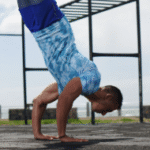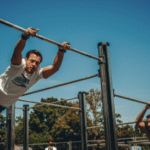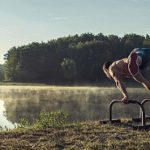Top 10 Exercises You’ll Master in Beginner Private Calisthenics Sessions
When you start your fitness journey with a private calisthenics coach in Houston, you’re not just getting a workout—you’re learning a new language of movement. The goal isn’t just to do exercises; it’s to master them with perfect form. This mastery is what builds a strong, injury-resistant foundation for all future progress.
Here are the top 10 foundational exercises a great coach will ensure you master, turning you from a novice into a competent and confident practitioner.
- The Australian Row (Inverted Row)
Why It’s a Foundation: This is the true starting point for all pulling strength. It teaches you to engage your back muscles (lats, rhomboids, traps) correctly, which is essential for eventually conquering the pull-up.
What You’ll Master:
Scapular Retraction: Your coach will teach you to initiate the pull by squeezing your shoulder blades together, not just yanking with your arms.
Body Line Integrity: You’ll learn to keep your body in a perfectly straight line from your head to your heels, engaging your glutes and core to prevent your hips from sagging.
Full Range of Motion: Mastering the movement from fully extended arms to touching your chest to the bar, building strength through the entire pattern.
Progression Path: Leads to lower, more difficult rows and eventually, the pull-up.
- The Incline Push-up
Why It’s a Foundation: It’s the safest and most effective way to build pushing strength. By adjusting the angle of your body, your coach can perfectly scale the difficulty to your current level, allowing you to master the form before you handle your full body weight.
What You’ll Master:
Proper Hand and Elbow Position: Learning to place your hands correctly and keep your elbows tucked (not flared) to protect your shoulder and wrist joints.
Total Body Tension: Understanding that a push-up is a moving plank. You’ll learn to keep your core, glutes, and legs tight throughout the movement.
Scapular Movement: Your coach will teach you how to let your shoulder blades come together on the way down and push them apart at the top, building crucial shoulder stability.
Progression Path: Leads to lower inclines and ultimately, a perfect floor push-up.
- The Box Squat
Why It’s a Foundation: This is the ultimate tool for teaching the correct squat pattern. It removes the fear of falling backward and forces you to initiate the movement by pushing your hips back, not just bending your knees.
What You’ll Master:
The Hip Hinge: Learning to sit back into the squat, which properly engages your powerful glutes and hamstrings.
Proper Depth and Alignment: Your coach will use the box to ensure you reach the correct depth (hips parallel to or below knees) while keeping your chest up and spine neutral.
Knee Tracking: Drilling the motor pattern of pushing your knees out so they track in line with your feet, preventing knee pain.
Progression Path: Leads to confident, full-depth bodyweight squats and single-leg variations.
- The Plank
Why It’s a Foundation: The plank is the cornerstone of all core stability. It teaches you how to resist extension in your spine, a skill that protects your lower back in almost every other exercise.
What You’ll Master:
The Posterior Pelvic Tilt (PPT): Your coach will teach you to slightly tuck your tailbone under, which fully engages your abdominals and glutes and prevents your lower back from sagging.
Creating Tension: Learning to actively push the ground away, protract your shoulder blades, and squeeze every muscle in your body to create a truly rigid “plank.”
Proper Breathing: Maintaining steady breathing while holding full-body tension.
Progression Path: Leads to more advanced core work like hollow body holds and ab wheel rollouts.
- The Dip Support Hold
Why It’s a Foundation: Before you can do a dip, you must be able to simply support your own body weight with stable shoulders. This isometric hold builds tremendous stability in your shoulder girdle and straight-arm strength in your triceps.
What You’ll Master:
Shoulder Depression: Your coach will teach you to actively push down and keep your shoulders away from your ears, preventing shrugging and impingement.
External Rotation: Learning to slightly turn the pits of your elbows forward, which stabilizes the shoulder joint.
Scapular Stability: Holding a strong, stable position without letting your shoulder blades wing out.
Progression Path: Leads to dip negatives and eventually, full dips.
- The Active Hang
Why It’s a Foundation: This simple exercise is a game-changer for grip strength and shoulder health. It’s the very first step in the pull-up journey.
What You’ll Master:
Grip Endurance: Simply hanging from a bar will rapidly increase the strength of your hands and forearms.
Shoulder Depression (in a hang): Learning to pull your shoulder blades down from a passive “dead hang” into an active, engaged position. This is the first part of a proper pull-up.
Shoulder Decompression: The passive hang portion provides a fantastic stretch for your lats and helps decompress the spine.
Progression Path: Leads to scapular pulls and pull-up negatives.
- The Glute Bridge
Why It’s a Foundation: Many people have “sleepy” glutes from sitting all day. The glute bridge teaches you how to isolate and activate your glute muscles, which are the powerhouse of your body.
What You’ll Master:
Targeted Glute Squeeze: Learning to drive through your heels and squeeze your glutes to lift your hips, rather than using your lower back or hamstrings.
Full Hip Extension: Achieving a straight line from your shoulders to your knees at the top of the movement.
Core Engagement: Keeping your ribcage down and abs braced to prevent arching your lower back.
Progression Path: Leads to single-leg glute bridges and provides the hip power for squats and lunges.
- The Hollow Body Hold
Why It’s a Foundation: This is the fundamental core position for gymnastics and advanced calisthenics. It teaches you how to create total-body tension in a flexed-spine position, which is essential for skills like levers and the L-sit.
What You’ll Master:
Lower Back Connection: Learning to press your lower back firmly into the floor, eliminating any space.
Compression: Engaging your abs to pull your ribcage toward your pelvis.
Progressive Difficulty: Your coach will guide you from a simple tuck hold to extending your legs and arms, finding the perfect level of challenge.
Progression Path: This is a foundational position used in countless advanced skills.
- The Wall Plank
Why It’s a Foundation: This is your first step into the world of handbalancing. It safely gets you comfortable with being inverted and starts building the shoulder strength and endurance needed for handstands.
What You’ll Master:
Overcoming Fear: Safely getting used to the sensation of having your weight on your hands.
Shoulder Stacking: Learning to align your hands, elbows, and shoulders in a straight, stable line.
Body Alignment: Maintaining a straight body line against the wall, just like in a regular plank.
Progression Path: Leads to wall-facing handstand holds and eventually, freestanding handstands.
- The Tuck L-Sit
Why It’s a Foundation: The L-sit is a phenomenal display of core compression and straight-arm strength. The tuck variation is the first achievable step.
What You’ll Master:
Shoulder Depression (under load): Actively pushing your body up and away from the floor (or parallettes), creating space.
Core Compression: Using your abs and hip flexors to pull your knees tightly toward your chest.
Scapular Depression: This is a recurring theme! You’ll master keeping those shoulders locked down and away from your ears.
Progression Path: Leads to single-leg extensions and the full L-sit.

Top 10 Exercises You’ll Master in Beginner Private Calisthenics Sessions
Route
Calisthenics Gym Houston Functional Bodyweight Training
Secondary phone: (346) 483-3195
Email: info@calisthenicsclubhouston.com
URL: https://calisthenicsclubhouston.com/
Monday 6:00 AM - 7:00 PM Tuesday 6:00 AM - 7:00 PM Wednesday 6:00 AM - 7:00 PM Thursday 6:00 AM - 7:00 PM Friday 12:00 PM - 6:30 PM Saturday 9:45 AM - 12:00 PM Sunday 3:00 PM - 5:00 PM





